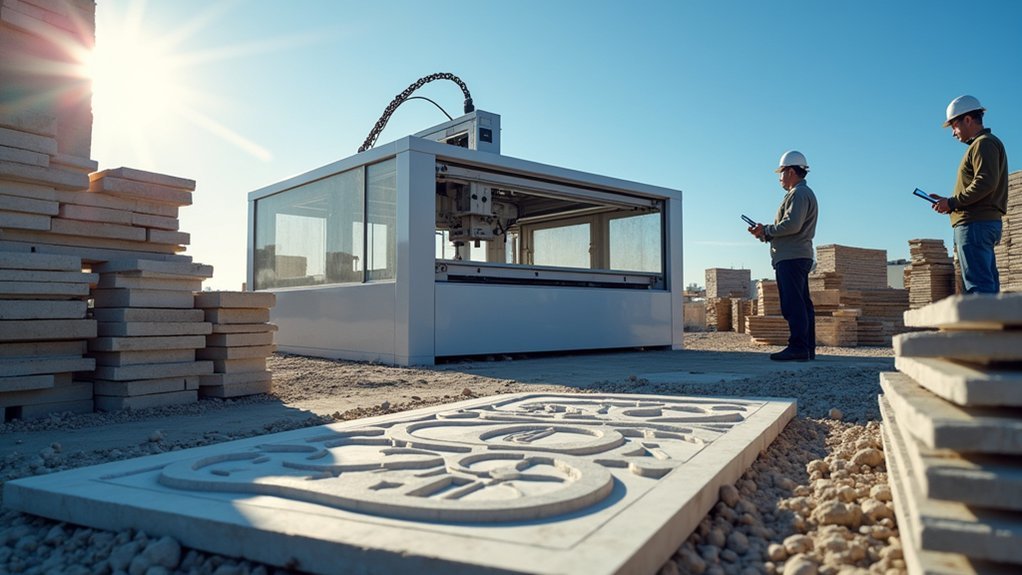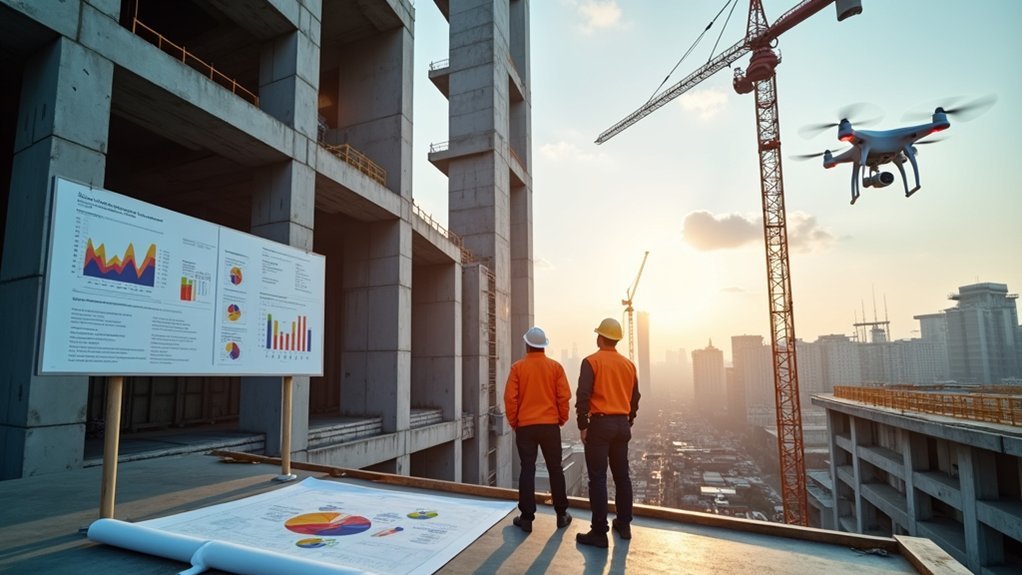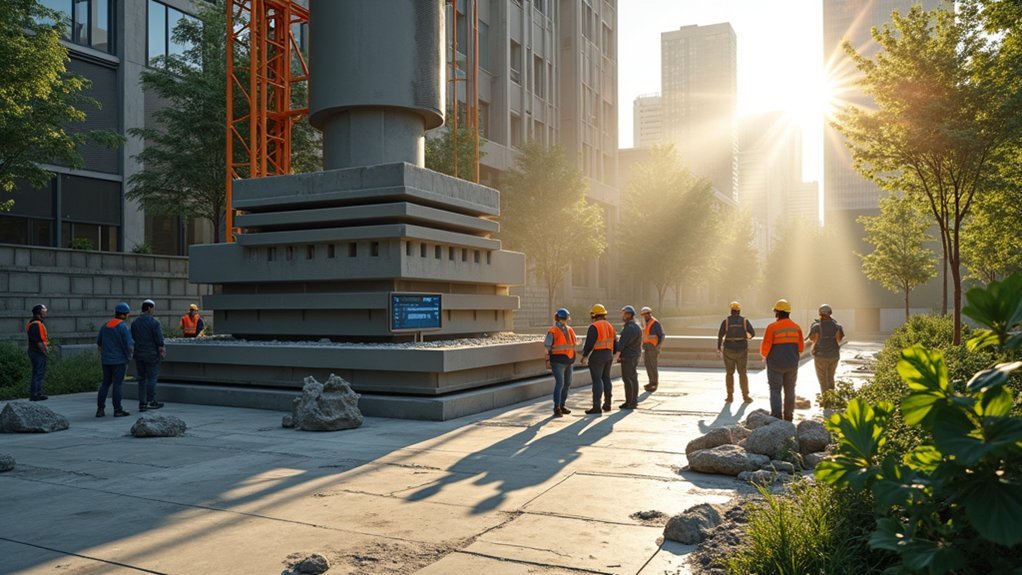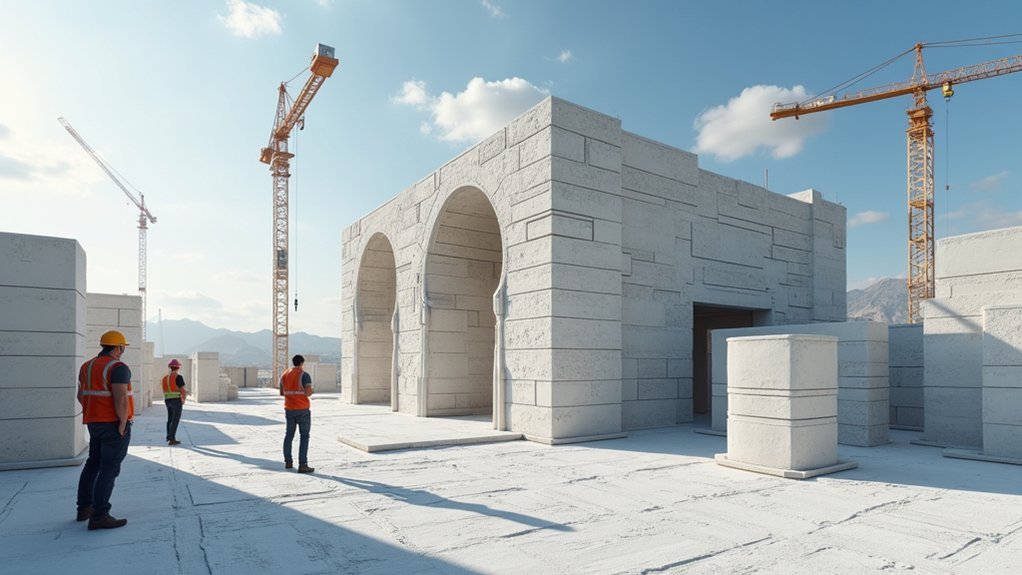You’ll achieve construction-scale 3D printing success by optimizing your design planning with BIM integration and maintaining 0.5mm tolerances for load-bearing components. Master key technologies like direct metal laser sintering while calibrating nozzle height and temperature precisely. Implement real-time quality control sensors for temperature and humidity monitoring. Develop specialized workforce skills through targeted training programs on additive manufacturing constraints. Finally, leverage cost-efficiency strategies using recycled materials and localized production to reduce waste by 60%. These fundamentals reveal deeper optimization possibilities.
Optimize Design Planning and Material Selection for Structural Integrity

While 3D printing offers unprecedented design freedom, you’ll achieve the best results by establishing a solid foundation through careful planning and smart material choices.
Start your construction projects by integrating BIM to guarantee structural integrity and enhance design efficiency through better visualization and stakeholder collaboration.
Choose compatible materials that match your 3D printing technology—durable concrete mixtures work well for extrusion-based systems, while high-strength polymers suit fused filament fabrication.
Your design specifications should include tolerances of at least 0.5mm, particularly for load-bearing components where precision matters most.
Implement topology optimization techniques to reduce material usage while maintaining strength.
During material selection, strategically incorporate support structures for overhangs, keeping angles under 50 degrees to prevent sagging during the printing process.
Master Key 3D Printing Technologies and Equipment Calibration
Once you’ve established your design foundation, mastering the core 3D printing technology becomes essential for achieving consistent, high-quality results. Understanding extrusion methods, powder bonding, and direct metal laser sintering helps you select the right construction technology for your project’s requirements.
Equipment calibration forms the backbone of successful operations. You’ll need to:
- Monitor nozzle height, temperature, and feed rate according to manufacturer specifications
- Verify material compatibility with your chosen printing system’s requirements
- Conduct regular quality assurance checks focusing on layer adhesion and print accuracy
Material properties directly impact structural integrity, so make certain your selected materials align with your printer’s capabilities.
Advanced slicing software enhances design refinement while reducing waste. Implementing robust calibration protocols and quality control measures guarantees peak performance throughout your construction-scale printing process.
Implement Real-Time Quality Control and Environmental Monitoring Systems

Successful large-scale printing requires sophisticated monitoring systems that track critical parameters in real-time.
You’ll need real-time quality control sensors monitoring temperature, humidity, and material consistency to maintain ideal printing conditions and guarantee structural integrity. Environmental monitoring systems detect ambient changes affecting material properties, enabling immediate adjustments that preserve print quality.
Data analytics from continuous monitoring provides insights into print performance, improving accuracy and repeatability for large-scale projects. Your monitoring systems offer continuous feedback, detecting defects during printing and enabling timely interventions for significant waste reduction.
Integrate IoT-enabled devices with your quality control systems to enable remote monitoring capabilities. This allows project managers to oversee multiple construction sites simultaneously, ensuring compliance with quality standards from any location while maintaining consistent oversight across operations.
Develop Specialized Workforce Skills and Training Programs
As construction-scale 3D printing technology advances, you’ll need to invest heavily in specialized workforce development to bridge the critical skills gap between traditional construction methods and additive manufacturing processes.
Your training programs must focus on essential technical competencies that enable workers to operate sophisticated printing equipment effectively.
Key areas for workforce training should include:
- Technical Operations: Master Direct Metal Laser Sintering (DMLS), extrusion methods, automated systems, and robotics integration
- Design Expertise: Understand design considerations for complex geometries, tolerance requirements, and additive manufacturing constraints
- Material Science: Learn material properties, compatibility factors, and selection criteria for various applications
You should collaborate with educational institutions to establish thorough certification programs.
This partnership approach guarantees your workforce develops the specialized skills necessary to leverage construction-scale 3D printing’s full potential while maintaining quality standards.
Leverage Cost-Efficiency Strategies While Maintaining Sustainability Standards

While traditional construction methods often force you to choose between cost savings and environmental responsibility, 3D printing technology eliminates this trade-off by making sustainability inherently profitable.
You’ll achieve remarkable cost savings through reducing waste—using only necessary materials cuts expenses by up to 60%. The precision of 3D printing minimizes material waste while supporting sustainable construction practices.
| Strategy | Cost Impact | Sustainability Benefit |
|---|---|---|
| Localized production | Lower transportation costs | Reduced carbon emissions |
| Recycled materials | Cheaper raw materials | Enhanced eco-friendliness |
| Automating construction | Reduced labor expenses | Consistent quality output |
| Waste reduction | 60% construction costs savings | Minimal environmental impact |
Focus on sourcing local materials for your projects. This localized production approach dramatically reduces transportation expenses while supporting regional suppliers and minimizing your carbon footprint.
Frequently Asked Questions
What Is the 45 Degree Rule for 3D Printing?
You should keep overhangs at 45 degrees or less from vertical to avoid needing support structures. This rule prevents sagging during printing, reducing material costs and post-processing time.
How to Properly Scale 3D Prints?
Scale your 3D prints by checking printer build volume limits, adjusting wall thickness for structural integrity, using scaling software to preserve proportions, and conducting test prints to identify potential issues.
What Is the Most Common 3D Print Fail?
You’ll encounter warping as the most common 3D print failure. It happens when your printed layers cool and contract unevenly, causing distortion that ruins your object’s shape and dimensions.
How to Make Abs Prints Stronger?
You’ll strengthen ABS prints by increasing nozzle temperature to 240-260°C, using a 90-110°C heated bed, slowing print speed to 40-60 mm/s, and implementing 30-50% infill density with strategic supports.





Leave a Reply